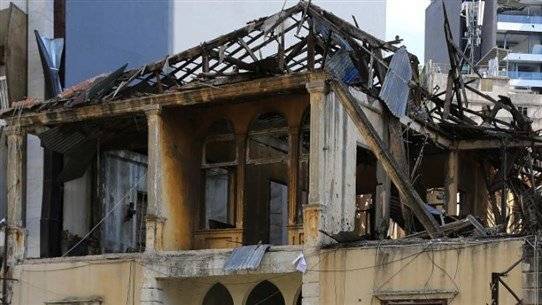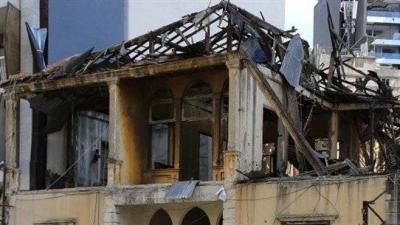As the effects of Law No. 194/2020, aimed at protecting areas affected by the explosion of August 4th, near their conclusion, Minister of Culture Mohamed Youssef Murtaza announced that the ministry has completed the necessary procedures to extend the law for presentation to the Cabinet. However, this does not necessarily mean protecting the buildings, as the law does not provide a clear mechanism for safeguarding approximately 1,175 classified heritage buildings that were 90% damaged, rendering its provisions ineffective, especially in light of the lack of specialized committees to implement it.
During the Egyptian rule of Beirut (1831-1840), the area surrounding the port transformed into a prosperous coastal spot after Ibrahim Pasha's decision to expand the port in preparation for accommodating ships. Following this period, residential clusters began to grow slowly, amidst unprecedented urban and economic prosperity, alongside the development of the railway in the "Mar Mikhael" area. This was followed by the era of the Ottoman Mutasarrifate, also known for its economic prosperity during which, according to engineer Abdel Halim Jibr, a middle class emerged that began to construct luxurious houses adorned with red tiles.
The areas surrounding the port, which have witnessed consecutive historical epochs, have also seen social transformations, particularly with the migration of residents from "the mountain." Architectural styles diversified, primarily influenced by the bourgeois character, alongside the spread of "Hawsh" spaces that blended old houses with green areas, as incoming residents sought to "intensify rural life" within the city, according to Jibr, constructing gardens within palaces and establishing water troughs.
### Law 194
This region, with its rich historical diversity, experienced an explosion two years ago that was classified as one of the largest non-military explosions in history. The blast affected around 85,744 housing units around the port, with 1,175 classified as heritage significantly damaged (90%), as their glass windows shattered, sandy walls separated, and terracotta and wooden roofs collapsed.
At that time, the greed of property speculators emerged as they attempted to seize damaged houses, while immediate interventions took place from the Beirut governorate and municipality, along with the engineering syndicates of Beirut and Tripoli, the Lebanese army’s emergency room, and the General Directorate of Antiquities. Their efforts culminated in the issuance of Law No. 194 two months after the explosion, aimed at "protecting the affected areas and supporting their reconstruction," and the ratification of a moratorium on property transactions for two years in the areas of Sassine, Medawwar, and Gemmayzeh, requiring the Ministry of Culture to devise a detailed plan for the restoration of damaged heritage buildings, prohibiting any construction listed on the inventory without ministry review.
### Immediate Intervention
Following the explosion, the Engineering Syndicate sent approximately 300 engineers to conduct structural assessments in the area, as stated by syndicate board member Tawfiq Sinan. They placed temporary signs on buildings to prevent their sale and to protect residents from collapse risks, with heritage houses receiving the largest share of damages and restoration challenges (150 buildings remained under restoration), as they require special preservation techniques.
As an increasing number of NGOs gathered around these historical buildings, the "Beirut Heritage Initiative" was launched on August 26, 2020, uniting various organizations concerned with heritage and saving historical buildings, suggesting immediate interventions in buildings (reinforcement and insulation to prevent water and air leaks by covering roofs, windows, and doors). Subsequently, the restoration phase began (approximately 650 heritage buildings near the port have been restored to date) along with reconstruction efforts and securing the funding necessary for these operations. These organizations divided the affected geographical area into zones and took it upon themselves to repair roofs and windows, with the ministry establishing decisive criteria for the working method. The presence of engineers from the "Institute of Fine Arts" at the Lebanese University contributed to these efforts, achieving about 70% of the work today, while noting that a portion remains uninhabitable.
In this same vein, UNESCO has become involved in the restoration and rehabilitation of several heritage and historical buildings, launching a fundraising campaign named "For Beirut" while warning, through its Director-General Audrey Azoulay, about the dangers of "speculative real estate dealings that exploit the residents' tragedy and vulnerability." Thus, heritage buildings have turned into a global issue, according to heritage specialist Juan Farshakh, who viewed what happened as a positive factor in placing Beirut in a state of emergency and also provided an opportunity to improve these buildings after the explosion.
### Absence of Implementation Mechanism
In a few weeks, the effects of Law No. 194 will conclude. According to Jibr, the law did not establish a clear mechanism for preserving heritage buildings and rendered its provisions ineffective, especially in the absence of specialized committees for its application amid the stagnation of the caretaker government and the lack of any political decision mandating the protection of these buildings.
A recent report issued by "Studio Public Works" titled "How do we protect the residents of the areas affected by the August 4 explosion and support their rehabilitation?" indicated that the law concerning property ownership and restrictions did not mention any new building permit processes, allowing any investor to construct towers or buildings incompatible with the traditional fabric of the area, inevitably leading to the distortion of neighborhood character and erasing historical identity. Furthermore, the law does not include any specific measures for heritage buildings that are not listed on the heritage inventory. Sinan also emphasizes the necessity of protecting these buildings, proposing that the owner be allocated property for investment elsewhere to preserve the area's identity due to the scarcity of these diminishing buildings in Beirut.
Thus, with the imminent expiration of the new law, the question of how to protect these buildings persists, while the protective law developed since 1996 remains shelved in parliament. What is to be done?
In this context, Minister of Culture Mohamed Wissam Murtada confirmed in a call with "An-Nahar" that his ministry has been working diligently on measures to protect heritage buildings by refraining from issuing any demolition permits for these structures. Murtada also pointed out that the ministry is taking steps to extend Law No. 194 to be discussed in the Council of Ministers. He revealed that the ministry is cooperating with UNESCO to prepare a comprehensive plan for the affected areas that maintains the heritage buildings and economically and socially develops neighborhoods. He also indicated the ministry's efforts to secure necessary funding for the reconstruction of heritage buildings and to produce regulatory and legal decrees that compensate owners through transferring investment rights without imposing any financial burdens on the state.




